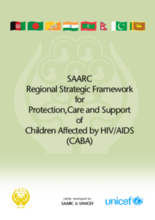The Regional Strategic Framework for the Protection, Care and Support of Children Affected by HIV/AIDS provides guidance to the eight member States of the South Asian Association for Regional Cooperation (SAARC) for a consistent approach across South Asia to protect, care and support children affected by HIV/AIDS. Between 2.3 and 3.7 million people in the SAARC region are estimated to be HIV positive. HIV/AIDS affects children in all parts of the SAARC.
It locates children affected by HIV/AIDS within the broader group of children in difficult circumstances, and focuses on delivering an integrated response to children’s medical, nutritional, educational, legal and psychosocial needs within the context of the UN Convention on the Rights of the Child that has been ratified by all SAARC Member States.
The Regional Framework promotes a universal approach to ensure children affected by HIV/AIDS have access to the same public and social support systems that are available to other children, rather than being separated or singled out. However, within this universal approach the Regional Framework calls for additional and specific measures in relation to overcoming the stigma that surrounds HIV/AIDS and for interventions on behalf of children discriminated against as a result of this stigma.
The Regional Framework recommends that the response be both age and gender sensitive; take into account the specific situation and location in which affected children live; and prioritise legal, policy and practical action to reduce stigma and discrimination around HIV/AIDS. It also recognises that many threats to the rights of children affected by HIV/AIDS relate to the health and survival of their parents; in this light, it encourages action to ensure expanded access to HIV testing, counseling and the appropriate treatment and care for those infected.
The Regional Framework takes into account that many of the children affected by HIV/AIDS are also at risk of HIV infection and that some may be HIV-positive. It promotes strong intervention-level linkages to essential HIV/AIDS prevention and treatment services for children and their families, including prevention of mother-to-child transmission.
The Regional Framework endorses five key strategies from the Global Framework as applicable and appropriate in the SAARC region:
1. Strengthen the capacity of families to protect and care for orphans and vulnerable children by prolonging the lives of parents and providing economic, psychosocial and other support;
2. Mobilise and support community-based responses to provide both immediate and long- term assistance to vulnerable households;
3. Ensure access for orphans and vulnerable children to essential services, including education, health care, birth registration and others;
4. Ensure that governments protect the most vulnerable children through improved policy and legislation and by channeling resources to communities; and
5. Raise awareness at all levels through advocacy and social mobilisation to create a supportive environment for children affected by HIV/AIDS.
The Regional Framework builds upon these five broad global strategies and recommends eight strategic approaches to guide interventions for children affected by HIV/AIDS in the SAARC region and proposes six areas of programmatic action for governments in relation to children affected by HIV/AIDS in the SAARC Region:
1. Inclusion and integration of children affected by HIV/AIDS into general development and social services;
2. Support for all families in difficult circumstances to keep and raise their children;
3. Legal protection and justice;
4. Appropriate use of alternative care, with institutional care as a last resort;
5. Strengthen evidence base; and
6. Strengthen coordination and involve all relevant stakeholders.
©South Asian Association for Regional Cooperation

